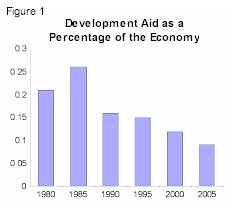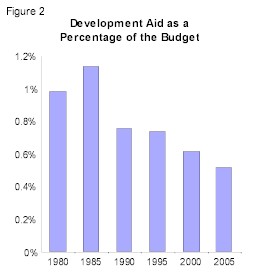| FOR
IMMEDIATE RELEASE: Tuesday, April 25, 2000 |
CONTACT:
Isaac Shapiro, Jim Jaffe, Michelle Bazie (202) 408-1080 |
U.S. AID TO POORER NATIONS, ALREADY LOW, HEADED DOWN
Development aid from the United States to other nations, as a share of the domestic economy, is on course to tie a post-World War II low in 2001. Such aid will also soon reach a half-century low as a share of government spending.
These trends are documented in a new report from the Center on Budget and Policy Priorities, Trends in U.S. Development Aid and the Current Budget Debate, which tracks aid spending patterns since the end of World War II.
 The analysis finds that under the latest Clinton
Administration budget, not only would aid in fiscal year 2001 tie a post-World War II low
by one key measure, but it would decline further in subsequent years. This would occur
even though the United States already spends a much smaller portion of its resources on
aid than any other comparable country.
The analysis finds that under the latest Clinton
Administration budget, not only would aid in fiscal year 2001 tie a post-World War II low
by one key measure, but it would decline further in subsequent years. This would occur
even though the United States already spends a much smaller portion of its resources on
aid than any other comparable country.
The report also contrasts the standard of living enjoyed by residents of the United States with that found in other nations. The average resident of the United States, the report calculates, receives 56 times the annual income of residents of the world's low-income countries. The U.S. economy comprises 27 percent of the world economy, while including only 5 percent of the world's population. The World Bank estimates that 1.2 billion residents of poor nations live on less than $1 a day.
Despite this context, the report finds, Congress has endorsed a budget path that may lead it to provide even lower levels of aid than the Administration has proposed.
"The United States would have to increase its aid commitment substantially either to reach the levels other wealthy nations provide or to return to its own level of commitment in earlier decades. But Congress' budget blueprint suggests legislators are more likely to reduce funding for development aid below the levels the Administration has requested than to raise funding," said Isaac Shapiro, director of the Center's international project and author of the report.
"Critics have recently asked whether the International Monetary Fund and the World Bank were doing as much as they should or as well as they could in helping poorer nations," Shapiro added. "The data suggest the same questions should be asked of U.S. efforts."
A companion report by the Overseas Development Council, issued simultaneously, suggests that many, though not all, aid programs have been successful. They have, for instance, contributed to dramatic public health advances. The ODC study also suggests there is an emerging consensus on how to make aid programs more successful.
Trends in U.S. Spending
The Center report analyzes data from the Office of Management and Budget, the U.S. Agency for International Development and the Paris-based Organization for Economic Co-Operation and Development (OECD). Viewing the domestic historic record, the report finds:
- The Administration's budget request for spending on development aid for fiscal year 2001 is only 0.11 percent of the U.S. economy, tied for the lowest percentage on record. The figures here reflect the budget category labeled "development and humanitarian" assistance as well as Economic Support Funds, and are available back to 1962. During the 1980s, such aid averaged nearly twice as large a percentage of the economy.
- The amount of aid requested would be 0.6 percent of federal
expenditures next year, a lower figure than throughout the 1962-97 period.

- Under the Administration's budget, development aid would drop further in subsequent years. By fiscal year 2003, U.S. aid — measured as either a share of the economy or as a share of the budget — would reach recorded new lows.
- In dollar terms, the United States budget contains $11.1 billion for development aid next year, significantly below the level of the 1980s. Adjusted for inflation, the Administration recommendation for next year is $10.7 billion.
Although the Administration has proposed an exceptionally low level of development aid spending for 2001, Congress is likely to adopt an even-lower figure. The Congressional budget resolution approved April 13 sets a target figure for overall international affairs spending that is significantly smaller than the Administration's proposal. The resolution does not include a specific level for the category of international affairs spending that is development aid.
The U.S. Compared to Other Countries
The report also examines OECD measures of "Official Development Assistance," which is aid targeted on poor countries. The OECD data indicate that under several measures, the United States provides less such aid than other industrial nations do.
- When compared to the other 20 donor nations in terms of the share of national resources devoted to development aid for poor countries in 1997-98, the United States provided the lowest share by far. The typical country contributed more than three times the share of national resources that the United States did.
- In per capita aid donations, the United States was next to the last. The United States contributed an amount equal to $29 per U.S. resident. In the other industrialized countries examined, the aid contribution typically was $70 per person.
- Although Japan's economy is less than half the size of the United States economy, Japan operates the largest foreign aid program (in dollars provided).
- The United Nations has established a target that donor nations should provide in aid to poor countries (Official Development Assistance) of 0.7 percent of the donor nation's gross domestic product. Four European nations exceeded this goal in 1997-98. The United States, however, contributed less than one seventh of the target.
Statistics cited in the report from different agencies cover different time spans and use somewhat differing definitions of aid. The U.S. Agency for International Development data track developmental aid back to 1946. The OECD data begin in 1950. The Office of Management and Budget data used to put aid in a broader budgetary context go back to 1962.
"In combination," the report concludes, "the data from these three sources indicate that under the Administration's budget, U.S. development aid in fiscal year 2001 would be tied for its lowest level since the end of World War II, measured as a share of the economy. Moreover, in subsequent years, the share would fall further, to record lows for the post-World War II period."
The Center on Budget and Policy Priorities is a nonpartisan research organization and policy institute that conducts research and analysis on a range of government policies and programs. It is supported primarily by foundation grants.
# # # #
To access the PDF files, right-click on the underlined text, click "Save Link As," download to your directory, and open document in Adobe Acrobat Reader.